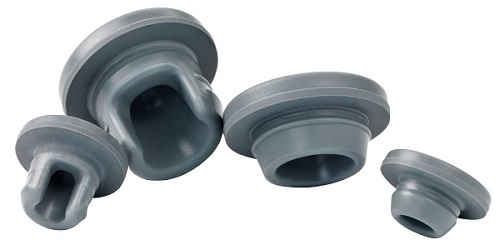Question: What type of vial stopper should I choose? Bromobutyl vs Chlorobutyl?
BROMOBUTYL VIAL STOPPERS VS CHLOROBUTYL VIAL STOPPERS
Serum vial stoppers are readily available in bromobutyl and chlorobutyl rubber formulations for use in pharmaceutical and biological packaging. During the vulcanization process of natural rubber (heating and curing), cross-linking of individual polymer chains form copolymers of isobutylene, and to a smaller extent, isoprene.By incorporating a halogen (bromine or chlorine) in the vulcanization process, the rate of vulcanization blending and curing performance is improved, and the cross-link bonding property has also significantly improved. Each specific halogen offers its own unique characteristics to the finished product.
Bromobutyl Rubber: a terpolymer of isobutylene, isoprene and brominated Isoprene.
Chlorobutyl Rubber: a terpolymer of isobutylene, isoprene and chlorinated Isoprene.
Processing with Bromine vs Chlorine
When bromine is used as the halogen for producing bromobutyl rubber, it is routinly added at a concentration of about 2%; whereas chlorine is added at a concentration of 1.1 – 1.5% in chlorobutyl rubber stoppers. Since bromine is more reactive than chlorine, a stabilizer is often added to the rubber (such as soybean oil at 1.3%) during the vulcanization of bromobutyl rubber. Since chlorine is more inert, it doesnt require the use of any stabilizers. The use of antioxidants (such as BHT) routinely used in both bromobutyl rubber and chlorobutyl rubber vial stopper manufacturing.
Advantages and Disadvantages: Bromobutyl Vial Stoppers vs Chlorobutyl Vial Stoppers
BROMOBUTYL
Bromobutyl Rubber Advantages: lower hygroscopicity and is a better choice for freeze dried / lyophilization product applications. Bromobutyl vial stoppers also have a higher stability and generally have a longer shelf life. Bromobutyl rubber has a faster cure rate and a shorter scorch or cure induction period (more efficient production) that requires lower levels of curatives and enables one to use a wider range of accelerators.
Bromobutyl Rubber Disadvantages: stabilizers are required in the production of bromobutyl rubber vial stoppers (such as soybean oil). Bromobutyl rubber also has greater heat sensitivity.
CHLOROBUTYL
Chlorobutyl Rubber Advantages: chlorobutyl vial stoppers have better resistance to heat and is the preferred stopper formulation for high-heat sterilization techniques. Chlorobutyl rubber vial stoppers are more efficiently produced without the use of stabilizers.
Chlorobutyl Rubber Disadvantages: longer curing times, resulting in higher production costs

